|
Books Should Be Free Loyal Books Free Public Domain Audiobooks & eBook Downloads |
|
|
Books Should Be Free Loyal Books Free Public Domain Audiobooks & eBook Downloads |
|
Kid's Books |
|---|
|
Book type:
Sort by:
View by:
|
By: Henrietta Elizabeth Marshall (1867-1941) | |
|---|---|
 Stories of Beowulf Told to the Children
Stories of Beowulf Told to the Children
The brave warrior, Beowulf, comes to the aid of King Hrothgar when he hears that Grendel, a horrible monster, is terrorizing the inhabitants of Hart Hall. Beowulf heroically battles Grendel, the Water Witch, and a fierce dragon. | |
 This Country of Ours, Part 7
This Country of Ours, Part 7
Another fine history book for children! Published in 1917, Marshall's book of stories from the history of the United States begins with accounts of exploration and settlement, and ends with the presidency of Woodrow Wilson.This is Part 7: Stories of the United States under the Constitution, from chapter 64 (Washington First in War, First in Peace) to chapter 99 (Wilson - The Great War). Read along and view the original illustrations at mainlesson.com . Part 1: http://librivox.org/this-country-of-ours-part-1-by-he-marshall/Part 2: http://librivox... | |
By: Henry James (1843-1916) | |
|---|---|
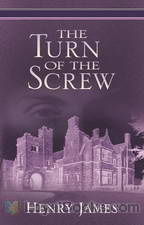 The Turn of the Screw
The Turn of the Screw
Christmas Eve. Guests round a fireside begin telling each other ghost stories. One of them relates a true incident involving the governess of his little nephew and niece. Strange events begin to take place, involving the housekeeper, a stranger who prowls round the grounds, a mysterious woman dressed in black and an unknown misdemeanor committed by the little nephew. The Turn of the Screw by Henry James was published in 1893 and it remains one of the best-known and admired works of this great American writer... | |
By: Henry Lee Mitchell Pike (1865-?) | |
|---|---|
 Our Little Korean Cousin
Our Little Korean Cousin
This book is one of a series that aims at describing other cultures to children in an entertaining way that honors the culture, educates the child and keeps their minds open to the possibility of other people living wonderful lives in far off places. "Until very recently little has been known of the strange land in which the subject of this tale lives. Recent events have done much to introduce Korea and its people to the world at large. For this reason the story of Yung Pak's youthful days may be the more interesting to his Western cousins... | |
By: Henry Wysham Lanier (1873-1958) | |
|---|---|
 Book of Giants
Book of Giants
Tales of very tall men of myth, legend, history, and science - Summary by Henry Wysham Lanier | |
By: Herbert Escott Inman (1860-1915) | |
|---|---|
 One-Eyed Griffin and Other Tales
One-Eyed Griffin and Other Tales
collection of children's fairytales including the tale of how the griffin lost one eye and Can't Shan't and Don't Care came to be giants. | |
By: Hezekiah Butterworth (1839-1905) | |
|---|---|
 Christmas Book
Christmas Book
For many kids, Christmas time is the most exciting time of the year. Reading stories such as these can help making this season extra special and exciting. Or they can bring a little Christmas spirit into a different time of the year if they are read and listened to in spring or summer. In any case, children and grown-ups will find them enjoyable. - Summary by Carolin | |
By: Homer Greene (1853-1940) | |
|---|---|
 Blind Brother
Blind Brother
This is the first book written by Homer Greene, whose primary occupation was lawyer. It tells of 14-year-old Tom Taylor, and his 12-year-old blind brother Bennie, who work in the Pennsylvania coal mines in the late 1800s, earning money for an operation for the younger lad. A story of strikes and mine "falls" (cave-ins) along the way. | |
 Riverpark Rebellion
Riverpark Rebellion
A tale of the Riverpark Academy for cadets, in which there is growing discontent leading to a revolt against the academy's leaders. The rebellion takes the form of an unauthorized "holiday" in which a number of cadets leave the grounds for a some fun, including attending a circus. The story follows one cadet's descent into dishonor and disgrace, and how he strives to become an honorable boy again. - Summary by Donald Cummings | |
 Whispering Tongues
Whispering Tongues
Parmenter and Lee are good friends who attend Concord College. But a hazing incident tears the friendship apart, and affects the lives of both the hazers and the hazee. And the whispering tongues of classmates of falsehoods, jealousy and rumor, serve only to make matters worse. Another heart-warming tale of disgrace and redemption from Homer Greene. | |
By: Horatio Alger, Jr. (1832-1899) | |
|---|---|
 Ragged Dick
Ragged Dick
A fourteen year old homeless boy, Dick, tries to make an honest living in the streets of 1860s New York as a bootblack. He is determined to stay honorable, though he is tempted many times to easy pickings and a life of crime. When a regular customer is impressed by Dick's integrity and invites him to his mansion, this marks a turning point in the life of the young street-smart teenager. Ragged Dick by Horatio Alger Jr was first published in 1868. It represents a typical coming of age story in which a child attains the maturity of adulthood through circumstances in which important choices are made... | |
 A Cousin's Conspiracy
A Cousin's Conspiracy
Ernest Ray is a young boy who sets out to reclaim the inheritance that was unjustly with held from his father and given to a cousin. (Introduction by Abigail Rasmussen) | |
 Mark the Match Boy or Richard Hunter's Ward
Mark the Match Boy or Richard Hunter's Ward
In this third installment from the “Ragged Dick” series by Horatio Algers, Jr., the reader is reacquainted with some old friends and meets young Mark Manton. Mark is a match boy plagued by bad luck and an even worse guardian. But, with new friends, hard work, and smart choices, Mark may just find his luck taking a turn for the better. summary by tfaulder | |
 Ben, The Luggage Boy; Or, Among the Wharves
Ben, The Luggage Boy; Or, Among the Wharves
Ben, after running away from home, must find a way to survive on the streets. According to the preface, the book was based on a true story told to the author by a real boy named Ben. - Summary by Elsie Selwyn | |
By: Howard Pyle (1853-1911) | |
|---|---|
 The Merry Adventures of Robin Hood
The Merry Adventures of Robin Hood
A modern day legend, Robin Hood is an archetypal hero of the common people who goes to great lengths to famously take from the rich and give to the poor. Luckily he is not alone in his mission, as his righteous views are shared by his band of Merry Men, a group of yeomen, and together they pursue an end to injustice and oppression. Set in medieval England, the tale begins with the introduction of a young archer, who is provoked into conflict and committing a crime against the formidable Sherriff of Nottingham and is immediately dubbed an outlaw... | |
 Otto of the Silver Hand
Otto of the Silver Hand
The story of little Otto, a gentle, peace-loving child born into the heart of turmoil and strife in the castle of a feuding robber baron in medieval Germany. (Summary by Arctura) | |
 The Garden Behind the Moon: A Real Story of the Moon Angel
The Garden Behind the Moon: A Real Story of the Moon Angel
David goes on a journey to the moon-garden where everything is beautiful and where he also meets Phyllis who is not like the other children in the garden. While he is allowed to play in this beautiful place for awhile, he at last finds out that he has been brought there to reveal his true mission, which is to find the Wonder-Box and the Know-All Book that is hidden in the Iron Castle and bring them back to earth. In order to find the Iron Castle, he must first find and tame the Black Winged Horse. Will he be able to succeed at the task given him? (Summary by Laura Victoria) | |
 Wonder Clock
Wonder Clock
"Four and twenty marvellous tales, one for each hour of the day," retold in a novel and entertaining manner by a master of the form. While drawing on German, English, and Scandinavian folk literature for many of his characters and plots, Pyle reworks the material in an imaginative way, crafting the tales in his own inimitable style. Equally engaging are the numerous woodcuts that accompany the stories and enliven the narrative. Read along and see the illustrations | |
By: Howard R. Garis (1873-1962) | |
|---|---|
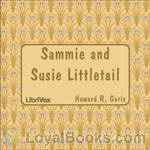 Sammie and Susie Littletail
Sammie and Susie Littletail
Once upon a time there lived in a small house built underneath the ground two curious little folk, with their father, their mother, their uncle and Jane Fuzzy-Wuzzy. Jane Fuzzy-Wuzzy was the nurse, hired girl and cook, all in one, and the reason she had such a funny name was because she was a funny cook. She had long hair, a sharp nose, a very long tail and the brightest eyes you ever saw. She could stay under water a long time, and was a fine swimmer. In fact, Jane Fuzzy-Wuzzy was a big muskrat, and the family she worked for was almost as strange as she was. (excerpt from text) | |
 Rick and Ruddy
Rick and Ruddy
This delightful story is full of ups and downs involving a young boy and his dog, "a gift from the sea". The adventures range from playful antics to times of peril, and through it all, our protagonists (both human and canine alike) come through for each other as only a dog and his boy can! This adventurous and fun tale will bring you back to your own childhood memories...you and that special tail-wagger from the "good ol' days". | |
 Uncle Wiggily and Old Mother Hubbard
Uncle Wiggily and Old Mother Hubbard
Uncle Wiggily Longears, an old bunny gentleman now stricken with rheumatism and getting around with a cane, still is quite active. In these stories, he encounters a string of characters from Mother Goose's tales and has adventures that are not quite in keeping with her books!These gentle tales are 7 - 8 minutes each and quite suited to a nightly reading to a small child. (Intro by Mark F. Smith) | |
 Umboo, The Elephant
Umboo, The Elephant
Have you ever wondered what it is like to be in a circus? What if, rather than choosing to be in one, you were captured and taken away from the home and family you knew and made to perform in the heat of a big top? Meet Umboo, the elephant, Chako, the monkey, Snarlie, the tiger and their circus friends and learn how life in the jungle was different from life in the circus. | |
 Uncle Wiggily's Automobile
Uncle Wiggily's Automobile
The irrepressible Uncle Wiggily falls ill and Dr. Possum prescribes "an automobile drive before every meal". thus Uncle Wiggly buys an automobile and sets out to be heals. His many adventures are filled with ducks, squirrels, crows and other excited animals so if you have always secretly wished to be one of these, this is you chance to do it. - Summary by phil chenevert | |
 Uncle Wiggily in Wonderland (Version 2)
Uncle Wiggily in Wonderland (Version 2)
Uncle Wiggily, the irrepressable flop eared rabbit, has more adventures and this time he goes underground through the strange world of Wonderland Alice. You are invited to hop along and see what odd and funny things happen. "Once upon a time, after Uncle Wiggily Longears, the nice bunny rabbit gentleman, had some funny adventures with Baby Bunty, and when he found that his rheumatism did not hurt him so much as he hopped on his red, white and blue striped barber pole crutch, the bunny uncle wished he might have some strange and wonderful adventures... | |
 Toodle and Noodle Flat-tail: The Jolly Beaver Boys
Toodle and Noodle Flat-tail: The Jolly Beaver Boys
Toodle and Noodle, the rambunctious young beaver boys take center stage in this book about their adventures. Fun, excitement and a bit of mischievousness make them always alert for the next curious turn in the trail. - Summary by phil chenevert | |
By: Hugh Lofting (1886-1947) | |
|---|---|
 The Voyages of Doctor Dolittle
The Voyages of Doctor Dolittle
The delightfully eccentric Doctor Dolittle, rendered immortal on screen by the gifted Rex Harrison, has remained a firm favorite with generations of children ever since he made his debut in an earlier novel, The Story of Doctor Dolittle. In his second outing titledThe Voyages of Doctor Dolittle, the maverick physician takes on a new assistant, Tommy Stubbins. The story is structured as a first person account given by Tommy, who is now a very old man. The boy who was the son of the village cobbler first meets Doctor Dolittle when he takes a hurt squirrel to the doctor for treatment... | |
 The Story of Doctor Dolittle
The Story of Doctor Dolittle
An adventurous children’s novel, The Story of Doctor Dolittle is the first book in the Doctor Dolittle series. The novel depicts the many adventures of Dr. John Dolittle as he learns the language of animals and takes on various feats including exotic travel, a dangerous encounter with pirates, and a mission to set right from wrong. The novel begins with the introduction of Dr. John Dolittle, an animal lover and respected physician, who lives in the small English town of Puddleby-on-the-Marsh with his unmarried sister... | |
By: Ida Coe and Alice Christie (1876-?) | |
|---|---|
 Story Hour Readers: Third Year
Story Hour Readers: Third Year
Short and sweet stories for children from the 19th century. The stories were compiled by two New York City teachers and were thought appropriate for third year children at that time. | |
By: J. C. Ryle (1816-1900) | |
|---|---|
 Two Bears, and Other Sermons for Children
Two Bears, and Other Sermons for Children
”Let no one make you think that you are too young to serve God. That is not true. As soon as you know right from wrong, you are old enough to begin taking the right way. As soon as you are old enough to be punished for doing wrong, you are old enough to give your heart to God, and to follow Christ.” So Rev. Ryle speaks to children of all ages. He does not speak down to children, for even the littlest ones can understand great spiritual truths. Instead, he teaches them in simple language what it means to be a true follower of Jesus and challenges them to live a better life whatever their age by following Jesus’ example – messages we adults could profit from as well... | |
By: J. M. Barrie (1860-1937) | |
|---|---|
 Peter Pan
Peter Pan
His name has become a metaphor for one who will never grow old. Peter Pan by JM Barrie is the story of a boy who remains a boy while the world around him changes. Sir James Mathew Barrie was a Scottish playwright and novelist whose works were received with great critical and commercial success in the late nineteenth and early twentieth century. He discovered the main inspiration for his creative genius in his friendship (and later guardianship) with the children of Arthur and Sylvia Llewellyn-Davies... | |
 The Story of Peter Pan
The Story of Peter Pan
THE STORY OF PETER PAN RETOLD FROM THE FAIRY PLAY BY SIR J.M. BARRIE BY DANIEL O'CONNOR. Basically, Daniel O'Connor took the story from the original play, with the approval of Barrie, and shortened it into a book with music and beautiful illustrations. This shorter book was published before Barrie wrote the longer novel using the same plot and characters. | |
 Peter and Wendy
Peter and Wendy
Peter and Wendy tells the classic story of Peter Pan, a mischievous little boy who can fly, and his adventures on the island of Neverland with Wendy and her brothers, the fairy Tinker Bell, the Lost Boys, the Indian princess Tiger Lily, and the pirate Captain Hook. (Introduction modified from Wikipedia) | |
 Little White Bird
Little White Bird
"A children's book, sharp social commentary and sad psychological thriller about a man's search for a sense of belonging. All in one amazing and lyrical collection. This is the first book in which Peter Pan starts to appear. His adventure in Kensington Gardens are first narrated here. Other than that, it offers a magical portrait of contemporary London, and a realistic tale of a family to which every one of us could have belonged." | |
By: Jacob & Wilhelm Grimm (1785-1863; 1786-1859) | |
|---|---|
 Snowdrop and Other Tales
Snowdrop and Other Tales
Many of these tales were published in English in 1909, the Brothers Grimm tales in this book were published separately in 1920 with illustrations by Arthur Rackham (1867-1939). | |
By: Jacob Abbott | |
|---|---|
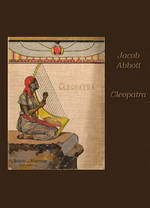 Cleopatra
Cleopatra
The French mathematician and philosopher, Blaise Pascal once remarked, “Cleopatra's nose. Had it been shorter, the whole face of the world would have been changed!” Such was the legendary power and attraction of this most famous woman ruler that generations of artists, readers, writers, historians and poets have ensured that she remains immortal and unforgettable. Jacob Abbott's Cleopatra is a work of historical biography, told in a highly dramatic and gripping style. It brings the characters and the circumstances to vivid life, making it an entertaining read for people of all ages... | |
 Queen Elizabeth
Queen Elizabeth
The history of a woman who rose above and beyond tragedy, grief and personal loss to become one of the most powerful figures in sixteenth century Europe is wonderfully told in this biography Queen Elizabeth, by Jacob Abbott. Beginning with the tragic circumstances of Elizabeth's mother, the lovely and doomed Anne Boleyn's execution and Henry VIII's dissolution of the English Catholic Church, the story of Elizabeth's rise to power is reflective of the England's domination of world politics as well... | |
 Hannibal
Hannibal
There are certain names which are familiar, as names, to all mankind; and every person who seeks for any degree of mental cultivation, feels desirous of informing himself of the leading outlines of their history, that he may know, in brief, what it was in their characters or their doings which has given them so widely-extended a fame. Consequently, great historical names alone are selected; and it has been the writer's aim to present the prominent and leading traits in their characters, and all the important events in their lives, in a bold and free manner, and yet in the plain and simple language which is so obviously required in works which aim at permanent and practical usefulness... | |
 William the Conqueror
William the Conqueror
There are certain names which are familiar, as names, to all mankind; and every person who seeks for any degree of mental cultivation, feels desirous of informing himself of the leading outlines of their history, that he may know, in brief, what it was in their characters or their doings which has given them so widely-extended a fame. Consequently, great historical names alone are selected; and it has been the writer’s aim to present the prominent and leading traits in their characters, and all the important events in their lives, in a bold and free manner, and yet in the plain and simple language which is so obviously required in works which aim at permanent and practical usefulness... | |
 Mary Queen of Scots
Mary Queen of Scots
There are certain names which are familiar, as names, to all mankind; and every person who seeks for any degree of mental cultivation, feels desirous of informing himself of the leading outlines of their history, that he may know, in brief, what it was in their characters or their doings which has given them so widely-extended a fame. Consequently, great historical names alone are selected; and it has been the writer’s aim to present the prominent and leading traits in their characters, and all the important events in their lives, in a bold and free manner, and yet in the plain and simple language which is so obviously required in works which aim at permanent and practical usefulness... | |
 Richard I
Richard I
There are certain names which are familiar, as names, to all mankind; and every person who seeks for any degree of mental cultivation, feels desirous of informing himself of the leading outlines of their history, that he may know, in brief, what it was in their characters or their doings which has given them so widely-extended a fame. Consequently, great historical names alone are selected; and it has been the writer’s aim to present the prominent and leading traits in their characters, and all the important events in their lives, in a bold and free manner, and yet in the plain and simple language which is so obviously required in works which aim at permanent and practical usefulness... | |
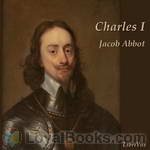 Charles I
Charles I
There are certain names which are familiar, as names, to all mankind; and every person who seeks for any degree of mental cultivation, feels desirous of informing himself of the leading outlines of their history, that he may know, in brief, what it was in their characters or their doings which has given them so widely-extended a fame. Consequently, great historical names alone are selected; and it has been the writer’s aim to present the prominent and leading traits in their characters, and all the important events in their lives, in a bold and free manner, and yet in the plain and simple language which is so obviously required in works which aim at permanent and practical usefulness... | |
By: Jacob Grimm (1785-1863), Wilhelm Grimm (1786-1859), and Andrew Lang (1844-1912) (1785-1863) | |
|---|---|
 Personal Collection of Short Tales compiled by Carmie
Personal Collection of Short Tales compiled by Carmie
This is a selection of the fairy tales (in English) written by Jacob Ludwig Carl Grimm and Wilhelm Karl Grimm in the early 19th Century. These stories are fantastical and although aimed squarely at the flexible mind of a child which can assimilate much stranger concepts than an adult they are quite dark and occasionally brutal. The stakes can be quite high as in Rumpelstiltskin where a terrible bargain is made without due regard to possible future consequences and Tom Thumb who seems forever about to be imprisoned or sliced in two... | |
By: James Baikie | |
|---|---|
 Peeps at Many Lands: Ancient Egypt
Peeps at Many Lands: Ancient Egypt
Written primarily for children, James Baikie’s ‘peep’ at ancient Egypt is a really well done, historical account of the ways of that fascinating land so many years ago. It has stood well the test of time, being both well researched and well written. It’s a fun book for everyone, and families especially will enjoy listening together. | |
By: James Baldwin (1841-1925) | |
|---|---|
 Fifty Famous Stories Retold
Fifty Famous Stories Retold
King Alfred and the Cakes. Damon and Pythias. The Sword of Damocles. Bruce and the Spider. These are stories that many people who grew up in the last century would be familiar with. They were included in our text books or to be found in anthologies in our school libraries. However, for a new generation growing up, some of these may be new and unknown. Hence, Fifty Famous Stories Retold by James Baldwin would indeed be a great addition to your children's bookshelf. James Baldwin, who shares his name with another famous American author was an editor, author and gifted teacher... | |
 Four Great Americans: Washington, Franklin, Webster, Lincoln. A Book for Young Americans
Four Great Americans: Washington, Franklin, Webster, Lincoln. A Book for Young Americans
Written for children, James Baldwin’s history of Washington, Franklin, Webster, and Lincoln brings these men to life in a way that will be interesting for adults as well. The stories touch on the little humanities of the great men, rather than dwelling on the great works and great events of their lifetimes, without ignoring the latter. | |
 Stories of Don Quixote : written anew for young people
Stories of Don Quixote : written anew for young people
The romance entitled "The Achievements of the Ingenious Gentleman, Don Quixote de la Mancha," was originally written in Spanish by Miguel de Cervantes Saavedra in the 17th century. It has been read and enjoyed by men and women of the most diverse tastes and conditions. The story is so simple that every one can understand it, and yet it has in it so much wisdom that the wisest may derive pleasure from it. It touches the sense of humor in every heart. It moves to pity rather than ridicule, and to tears as well as laughter... | |
By: James Otis (1848-1912) | |
|---|---|
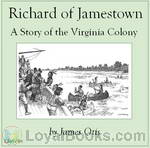 Richard of Jamestown: A Story of the Virginia Colony
Richard of Jamestown: A Story of the Virginia Colony
Richard of Jamestown by James Otis was written for children with the purpose to show them the daily home life of the Virginia colonists. It is written from the viewpoint of a young boy named Richard Mutton. | |
 Ruth of Boston: A Story of the Massachusetts Bay Colony
Ruth of Boston: A Story of the Massachusetts Bay Colony
James Otis wrote a series of books depicting life in the new colonies, written from a child’s point of view. Ruth of Boston is the story of 12 year old Ruth, coming from London to live in the Massachusetts Bay Colony. It gives accounts of what a girl’s daily life might have been like during the beginnings of this colony. | |
 Toby Tyler or Ten Weeks with a Circus
Toby Tyler or Ten Weeks with a Circus
Toby Tyler tells the story of a ten year-old orphan who runs away from a foster home to join the traveling circus only to discover his new employer is a cruel taskmaster. The difference between the romance of the circus from the outside and the reality as seen from the inside is graphically depicted. Toby's friend, Mr. Stubbs the chimpanzee, reinforces the consequences of what happens when one follows one's natural instincts rather than one's intellect and conscience, a central theme of the novel. | |
By: James Parton (1822-1891) | |
|---|---|
 Captains of Industry
Captains of Industry
In this volume are presented examples of men who shed lustre upon ordinary pursuits, either by the superior manner in which they exercised them or by the noble use they made of the leisure which success in them usually gives. Such men are the nobility of republics.Most of these chapters were published originally in "The Ledger" of New York, and a few of them in "The Youths' Companion" of Boston, the largest two circulations in the country. I have occasionally had reason to think that they were of some service to young readers, and I may add that they represent more labor and research than would be naturally supposed from their brevity... | |
By: James Whitcomb Riley (1849-1916) | |
|---|---|
 Selected Riley Child-Rhymes
Selected Riley Child-Rhymes
Riley was an American writer known as the “Hoosier poet”, and made a start writing newspaper verse in Hoosier dialect for the Indianapolis Journal in 1875. His favorite authors were Burns and Dickens. This collection of poems is a romanticized and mostly boy-centered paean to a 19th century rural American owning-class childhood. I’ve included the pieces I did because they’re the ones I most enjoyed when I read a copy of the collection handed down from my great-grandfather. | |
By: Jane Andrews (1833-1887) | |
|---|---|
 The Stories Mother Nature Told Her Children
The Stories Mother Nature Told Her Children
“You may think that Mother Nature, like the famous “old woman who lived in the shoe,” has so many children that she doesn’t know what to do. But you will know better when you become acquainted with her, and learn how strong she is, and how active; how she can really be in fifty places at once, taking care of a sick tree, or a baby flower just born; and, at the same time, building underground palaces, guiding the steps of little travellers setting out on long journeys, and sweeping, dusting, and arranging her great house,–the earth... | |
By: Jane Eayre Fryer | |
|---|---|
 Mary Frances Cook Book
Mary Frances Cook Book
Another of the charming Mary Frances books, this one 'Among the Kitchen People', where young girls are encouraged to be mother's helper's in the kitchen, as Mary Frances wants nothing more than to be useful. She learns how to make tea, toast and boiled eggs, among other things, as she enjoys adventures with her many friends, including Mantel Clock, Auntie Rolling Pin and Yellow Bowl. - Summary by Lynne Thompson | |
 Mary Frances Sewing Book
Mary Frances Sewing Book
This enchanting book was first published in 1913 “for all girls who love to make pretty things”. Meet Tommy Pin Cushion, Mr. Silver Thimble, Ma Chine, and many other delightful characters, along with the mysterious Needle-of-Don’t-Have-to-Try and the magic fairy lady, who truly serve to show that the best way to learn is through fun! Mary Frances, through the witty, jolly help of the Thimble People, learns easy step-to-step projects from basic stitches that gradually introduce simple patterns and projects to make a beautiful vintage wardrobe for a 16 inch doll. | |
By: Jean de La Fontaine (1621-1695) | |
|---|---|
 Fables in Rhyme for Little Folks
Fables in Rhyme for Little Folks
Several of La Fontaine’s fables, translated into English by W. T. Larned. | |
By: Jean Ingelow (1820-1897) | |
|---|---|
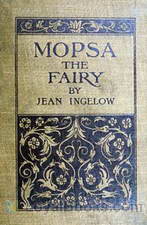 Mopsa the Fairy
Mopsa the Fairy
Jean Ingelow (1820 – 1897) was one of the more famous poets of the period, indeed many people suggested that she should succeed Alfred, Lord Tennyson as the first female Poet Laureate when he died in 1892. Mopsa the Fairy, written in 1869 is one of her more enduring stories. It is a delightful fantasy about a young boy who discovers a nest of young fairies and tells of their adventures together. | |
By: Jean M. Thompson (1865-?) | |
|---|---|
 Three Bears of Porcupine Ridge
Three Bears of Porcupine Ridge
Twenty-four delightful tales for children. Meet Timothy Mouse, Little Red Doe, Dame Woodchuck, King Moose and Unk-Wunk the Porcupine with their friends. Adventure and humor are skillfully wrapped around these lovable characters. | |
By: Jean Webster (1867-1916) | |
|---|---|
 Dear Enemy
Dear Enemy
Dear Enemy is the sequel to Jean Webster’s novel Daddy-Long-Legs. The story as presented in a series of letters written by Sallie McBride, Judy Abbott’s college mate in Daddy-Long-Legs. Among the recipients of the letters are the president of the orphanage where Sallie is filling in until a new director can be installed, his wife (Judy Abbott of Daddy-Long-Legs), and the orphanage’s doctor (to whom Sallie addresses her letters: “Dear Enemy”). | |
By: Jennie Hall (1875-1921) | |
|---|---|
 Viking Tales
Viking Tales
Viking tales are tales from Iceland, featuring the king Halfdan and his son Harald. | |
By: Jennie Irene Mix | |
|---|---|
 Mighty Animals
Mighty Animals
A book about dinosaurs written for children. In short, easy to read chapters designed to keep the interest of juvenile readers. | |
By: Jesse Lyman Hurlbut (1843-1930) | |
|---|---|
 Hurlbut's Story of the Bible
Hurlbut's Story of the Bible
As a parent, many of us would like our children to be familiar with our sacred books, no matter to which religion or faith we belong. However, very young children may find the language and the ideas quite difficult to assimilate. Yet the stories are so memorable and valuable that we want our children to know them as early as possible. Published in 1905, Hurlbut's Story of The Bible – 1 is a wonderful compilation of some of the most important and delightful stories to be found in both the Old and New Testaments... | |
By: Jessie Graham Flower (died 1931) | |
|---|---|
 Grace Harlowe's First Year at Overton College
Grace Harlowe's First Year at Overton College
Set after the Grace Harlowe High School series, Grace and her friends Miriam and Anne start a new chapter of their lives as Freshmen at Overton College. After various trials and tribulations they earn the respect of the elder classes and become valued members of the school. (Introduction by BumbleVee) | |
 Grace Harlowe's Senior Year at High School; or, The Parting of the Ways
Grace Harlowe's Senior Year at High School; or, The Parting of the Ways
The four series follow Grace Harlowe and her friends through high school, college, abroad during World War I, and on adventures around America. In The High School Girls Series, Grace attends Oakdale High School with friends Anne Pierson, Nora O'Malley, and Jessica Bright. The four promote fair play and virtue while winning over troubled girls like Miriam Nesbit and Eleanor Savell, playing basketball, and founding sorority Phi Sigma Tau. The group becomes friends with boys in their acquaintance: David Nesbit, Tom Gray, Hippy Wingate, and Reddy Brooks, forming "The Eight Originals." | |
 Grace Harlowe's Fourth Year at Overton College
Grace Harlowe's Fourth Year at Overton College
The four series follow Grace Harlowe and her friends through high school, college, abroad during World War I, and on adventures around America. In The High School Girls Series, Grace attends Oakdale High School with friends Anne Pierson, Nora O'Malley, and Jessica Bright. The four promote fair play and virtue while winning over troubled girls like Miriam Nesbit and Eleanor Savell, playing basketball, and founding sorority Phi Sigma Tau. The group becomes friends with boys in their acquaintance: David Nesbit, Tom Gray, Hippy Wingate, and Reddy Brooks, forming "The Eight Originals." (Introduction by Wikipedia) | |
 Grace Harlowe's Golden Summer
Grace Harlowe's Golden Summer
The College Girls Series sees the friends part ways: Grace, Anne, and Miriam depart for Overton College, while Jessica and Nora attend a conservatory. The Eight Originals gather on holidays, but the seven College books focus on the three at Overton, along with new friends like J. Elfreda Briggs. They form Semper Fidelis, a society devoted to aiding less fortunate students at Overton. Following graduation, Grace rebuffs offers of marriage for "what she had firmly believed to be her destined work," managing Harlowe House at Overton. | |
 Grace Harlowe's Return to Overton Campus
Grace Harlowe's Return to Overton Campus
The four series follow Grace Harlowe and her friends through high school, college, abroad during World War I, and on adventures around America. In The High School Girls Series, Grace attends Oakdale High School with friends Anne Pierson, Nora O'Malley, and Jessica Bright. The four promote fair play and virtue while winning over troubled girls like Miriam Nesbit and Eleanor Savell, playing basketball, and founding sorority Phi Sigma Tau. The group becomes friends with boys in their acquaintance: David Nesbit, Tom Gray, Hippy Wingate, and Reddy Brooks, forming "The Eight Originals... | |
 Grace Harlowe's Problem
Grace Harlowe's Problem
The four series follow Grace Harlowe and her friends through high school, college, abroad during World War I, and on adventures around America. The College Girls Series sees the friends part ways: Grace, Anne, and Miriam depart for Overton College, while Jessica and Nora attend a conservatory. The Eight Originals gather on holidays, but the seven College books focus on the three at Overton, along with new friends like J. Elfreda Briggs. They form Semper Fidelis, a society devoted to aiding less fortunate students at Overton. Following graduation, Grace rebuffs offers of marriage for "what she had firmly believed to be her destined work," managing Harlowe House at Overton. | |
 Grace Harlowe with the U.S. Troops in the Argonne
Grace Harlowe with the U.S. Troops in the Argonne
Grace Harlowe continues her adventures in Europe, during World War I. She faces many perils and suffers heart ache, but still puts all of her effort into the war, driving her ambulance to help the injured American soldiers. | |
 Grace Harlowe with the Yankee Shock Boys at St. Quentin
Grace Harlowe with the Yankee Shock Boys at St. Quentin
Grace Harlowe with the Yankee Shock Boys at St. Quentin finds Grace an active participant in that most brilliant single achievement of the war, the breaking of the Hindenburg Line. | |
 Grace Harlowe with the American Army on the Rhine
Grace Harlowe with the American Army on the Rhine
Although the war has ended, Grace still faces many trials as she continues her journey to the Rhine, when she discovers Germans still plotting against the American army. - Summary by ashleighjane | |
By: Jim Kjelgaard (1910-1959) | |
|---|---|
 The Black Fawn
The Black Fawn
Bud Sloan was an orphan who had been 'sold out' of the orphanage to work on a farm once he'd been old enough to labor. The farm where he was to work was owned by an aging farmer and his wife who had raised a large family and were now left alone. One day, after his chores were done, Bud wandered into the woods nearby and with mouth agape, he noticed a newborn jet black fawn all alone and apparently confused in his new surroundings. Bud resolved that day that this baby fawn was just like himself, an orphan, and would be bound to him in spirit... | |
By: Joel Chandler Harris (1848-1908) | |
|---|---|
 Uncle Remus
Uncle Remus
Bearing a striking resemblance to Aesop of Aesop's Fables fame, American author Joel Chandler Harris' Uncle Remus is also a former slave who loves to tell simple and pithy stories. Uncle Remus or to give it its original title, Uncle Remus: His Songs and His Sayings was published in late 1880 and received instant acclaim. The book was reviewed in hundreds of journals and newspapers across the country, leading to its immense success, both critical and financial. “Remus” was originally a fictional character in a newspaper column... | |
 Uncle Remus and Brer Rabbit
Uncle Remus and Brer Rabbit
Uncle Remus' stories feature a trickster hero called Br'er Rabbit ("Brother" Rabbit), who uses his wits to slide out of trouble and gain the advantage over the slower witted other animals, many of whom are trying to eat him. Br'er Rabbit stories were mostly collected directly from the afro-american oral story-telling tradition and are said to be a direct interpretation of Yoruba tales of Hare. This book contains 11 unique stories and was the last one published before the author's death. (Introduction by Phil Chenevert) | |
 Nights With Uncle Remus
Nights With Uncle Remus
That the little boy loved Uncle Remus and his stories was so obvious that the tale-spinning sessions began drawing additional listeners. Daddy Jack, an old "Africa man" visiting from down-state; Sis Tempy, the strong chief of the mansion's servants; and Tildy, a young and pretty servant-girl - all found their way to Uncle Remus' rude cabin when their duties or interests permitted, to sit around the hearth and hear the wonderful tales of the animals, and foremost among them, Brer Rabbit and Brer Fox... | |
 The Tar Baby and Other Rhymes of Uncle Remus
The Tar Baby and Other Rhymes of Uncle Remus
26 of Uncle Remus's stories put into verse and song. With the exception of the Tar Baby story, they were all new to this publication of 1904 and cover a variety of humorous subjects from Adan and Eve (De Appile Tree) to Brer Rabbit's Gigglin' Place. There are also genuine Camp Meeting Songs and a Corn Shuckin' Song. | |
 Uncle Remus Returns
Uncle Remus Returns
Uncle Remus tells these 11 stories but to the son of the original "little boy" who is visiting his grandmother on the plantation. As always Uncle Remus can be relied upon to provide funny and pointed insight into human personalities through his story telling. These were all published in the Uncle Remus magazine from 1905 and 1906 and gathered together in this book by the author. Note that these stories are reflections of another period in time and some of the language used would definitely be considered rude and/or offensive now. In keeping with the desire to present the text as the author wrote it, nothing has been changed or edited. | |
By: Johann David Wyss (1743-1818) | |
|---|---|
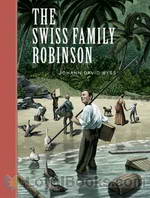 The Swiss Family Robinson
The Swiss Family Robinson
A beautiful story about survival, the Robinson family shows that one does not have to have the usual comforts of life in order to be comfortable and happy. It is also a story about family relations. The book showcases a family of six that has to start all over without the basic amenities that make life easier in the eyes of society. The idea of being in an island with no human neighbors is daunting to say the least. The family was shipwrecked and everyone else on the ship perished when they deserted the ship... | |
By: Johanna Spyri (1827-1901) | |
|---|---|
 Heidi
Heidi
Filled with descriptions of the magnificent Swiss Alps, the lives of the simple country folk who live in their picturesque peaks and valleys and the gentle and innocent days of childhood, Heidi by Johanna Spyri is a book that no child should miss reading. Since it first came out, it has captured the hearts of children (and adults) all over the world, been extensively filmed, televised and staged and translated from the original German into more than 60 languages. Heidiland, a theme park, is one of the big attractions in Zurich... | |
 Heidi (version 2 dramatic reading)
Heidi (version 2 dramatic reading)
"Heidi" takes us on a journey to the eventful childhood of a good-hearted girl from the Swiss Alps. A warm and loving story, full of touching moments, it reaches children and adults alike. It was written in 1880 and published in two parts: 1. Heidi's years of learning and travel. 2. Heidi makes use of what she has learned. This English translation from 1915 has "an especial flavor, that very quality of delight in mountain scenes, in mountain people and in child life generally, which is one of the chief merits of the German original... | |
 Maezli
Maezli
"Mäzli" may be pronounced the most natural and one of the most entertaining of Madame Spyri's creations. The atmosphere is created by an old Swiss castle and by the romantic associations of the noble family who lived there. Plot interest is supplied in abundance by the children of the Bergmann family with varying characters and interests. A more charming group of young people and a more wise and affectionate mother would be hard to find. Every figure is individual and true to life, with his or her special virtues and foibles, so that any grown person who picks up the volume will find it a world in miniature and will watch eagerly for the special characteristics of each child to reappear... | |
 Moni the Goat-Boy
Moni the Goat-Boy
Moni is the goat boy who takes care of all the goats belonging to the people of Fideris, Switzerland. He loves to sing, yodel, and whistle while he romps with the goats all day long on the mountains. His favorite is a young kid named Mäggerli. One day Moni comes across a serious situation where he must keep a deceitful secret in order to protect Mäggerli from being killed. Will Moni risk the life of Mäggerli and tell the truth? This delightful short story teaches children that to trust God and do right is always better than being deceitful. | |
 What Sami Sings With The Birds
What Sami Sings With The Birds
Old Mary Ann has done her best to bring up her son on her own. Like other relatives, her son has a longing to travel off over the mountains. Mary Ann goes with him. Later on her son marries, but loses his wife after she gives birth to their son. Mary Ann assumes responsibility of her grandson, while her son moves away in the agony of his grief. This is the story of what happens to her grandson and where his Grandmother, the songs of the birds, and his faith leads him. | |
 Cornelli
Cornelli
Cornelli lives in Iller-Stream with her widowed father, who calls on two Ladies of Culture to come spend time with Cornelli during one of his business trips, hoping that their influence will refine and improve his daughter. Instead, the ladies prove to have no real love for Cornelli, and she, being a sensitive soul, turns inward and becomes sullen and uncooperative. A boy who comes on a visit to Iller-Stream for his health befriends her, and this begins a chain of events that turn Cornelli's life right-side up again. | |
 Rose Child
Rose Child
The story of a little girl in the village of Wildbach, who loved the roses, and how spreading both her roses and her love touched the hearts of the villagers. | |
 Vinzi: A Story of the Swiss Alps
Vinzi: A Story of the Swiss Alps
At 12 years old, Vinzi's only desire is to study his beloved music. But his father wants to make a farmer of him, and is displeased whenever he finds Vinzi yielding to his musical inclination. Mother and sister look on wistfully as circumstances go beyond their control, but throughout, they trust to the protection of their Father in Heaven. This is another book by Johanna Spyri, author of Heidi. Here too, against the backdrop of the beautiful Swiss alps, she intertwines love, sincerity, and the freshness of youth to present a captivating story for young and old alike. - Summary by Rosebud | |
By: John Burroughs (1837-1921) | |
|---|---|
 Squirrels and other Fur-Bearers
Squirrels and other Fur-Bearers
Squirrels and other Fur-Bearers, a collection of essays by American naturalist and essayist, John Burroughs, provides fascinating insight into the daily life of small woodland creatures. Included in these essays are Burrough’s personal observations of squirrels, rabbits, mink, and chipmunks, as well as numerous other small mammals. Highly recommended for anyone, both young and old, with an interest in nature and wildlife! | |
By: John Cargill Brough (1834-1872) | |
|---|---|
 The Fairy Tales of Science
The Fairy Tales of Science
This book, written in the mid 19th century and illustrated by Charles H. Bennett, provides an entertaining introduction to topics in science for children. In each chapter, the author uses a popular myth or fairy tale to lay the groundwork for an equally fascinating "fairy tale of science" full of interesting facts and real life examples. | |
By: John Dutton Wright (1866-1952) | |
|---|---|
 What the Mother of a Deaf Child Ought to Know
What the Mother of a Deaf Child Ought to Know
Wright, a pioneer in the education of the deaf, was a strong advocate for acoustic and auricular training. In this little book, he tries to advise the parents of deaf children and reassure them that there can be a successful and happy life for them. | |
By: John H. Haaren (1855-1916) | |
|---|---|
 Famous Men of the Middle Ages
Famous Men of the Middle Ages
“THE study of history, like the study of a landscape, should begin with the most conspicuous features. Not until these have been fixed in memory will the lesser features fall into their appropriate places and assume their right proportions. The famous men of ancient and modern times are the mountain peaks of history. It is logical then that the study of history should begin with the biographies of these men. Not only is it logical; it is also pedagogical. Experience has proven that in order to attract and hold the child’s attention each conspicuous feature of history presented to him should have an individual for its center... | |
 Famous Men of Greece
Famous Men of Greece
Famous Men of Greece is a series of biographical sketches written for the purpose of making the study of history lively and interesting by giving insight into the men who lived during this time. | |
 Famous Men of Rome
Famous Men of Rome
Famous Men of Rome is a series of biographical sketches written for the purpose of making the study of history lively and interesting by giving insight into the men who lived during this time. | |
By: John Kendrick Bangs (1862-1922) | |
|---|---|
 A Little Book Of Christmas
A Little Book Of Christmas
Summary: Four short Christmas stories, a bit sentimental, but still affecting and worthwhile. Plus Four Christmas verses. (Summary by David Wales) | |
By: John Lang (1816-1864) | |
|---|---|
 Gulliver's Travels, Told to the Children
Gulliver's Travels, Told to the Children
This is a children's version of Jonathan Swift's novel Gulliver's Travels, from the Told to the Children Series (published in 1910). The children's adventure story covers Gulliver's visits to the lands of Lilliput and Brobdingnag. | |
By: John Meade Falkner (1858-1932) | |
|---|---|
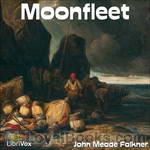 Moonfleet
Moonfleet
The novel is set in a fishing village in Dorset during the mid 18th century. The story concerns a 15 year old orphan boy, John Trenchard, who becomes friends with an older man who turns out to be the leader of a gang of smugglers.One night John chances on the smugglers’ store in the crypt beneath the church. He explores but hides behind a coffin when he hears voices. He finds a locket which contains a parchment, in the coffin belonging to Colonel Mohune. Unfortunately after the visitors leave,... | |
By: John Rae (1882-1963) | |
|---|---|
 New Adventures of Alice
New Adventures of Alice
After reading and re-reading the book many time as a boy and wishing that Lewis Carroll would have written another Alice In Wonderland Book, John Rae began imagining what that girl would have gotten up to if he had done so. Telling these stories to his children over the years, where they were enthusiastically received, he finally decided to share them with the world. And here they are! The New Adventures of Alice | |
By: Johnny Gruelle (1880-1938) | |
|---|---|
 Raggedy Andy Stories
Raggedy Andy Stories
Raggedy Ann is a fictional character created by writer Johnny Gruelle (1880–1938) in a series of books he wrote and illustrated for young children. Raggedy Ann is a rag doll with red yarn for hair. The character was created in 1915 as a doll, and was introduced to the public in the 1918 book Raggedy Ann Stories. A doll was also marketed along with the book to great success. A sequel, Raggedy Andy Stories (1920) introduced the character of her brother, Raggedy Andy, dressed in sailor suit and hat. | |
By: Johnny Gruelle (1880-1938) | |
|---|---|
 Raggedy Ann Stories
Raggedy Ann Stories
To the millions of children and grown-ups who have loved a Rag Doll, the author dedicated these stories. Now listen as Shannon reads to you Raggedy Ann’s exciting adventures; as gentle and charming today, as they were when first published in 1918. Find out what is written on her candy heart, what was the gift the fairies brought, and all about Raggedy Ann’s new sisters. | |
By: Joseph Alexander Altsheler (1862-1919) | |
|---|---|
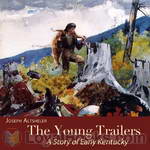 The Young Trailers: A Story of Early Kentucky
The Young Trailers: A Story of Early Kentucky
This is the story of Henry Ware, a young boy living in the wilds of the Kentucky frontier of the 1700's. The story follows Henry as he helps to establish a frontier outpost, is captured by an Indian tribe, and ultimately ensures the safety and security of a band of settlers against the warring Shawnee Indians. The Young Trailers is action packed and brings to life the adventures that awaited the early settlers as they traversed into the endless forests of the American frontier. | |
 The Guns of Shiloh
The Guns of Shiloh
The Northern Army has just be handed a great defeat at Bull Run and is headed back to Washington, DC. How will the North answer this defeat? Follow our hero, Dick Mason, into the Western campaign to find out.This is the second book in the Civil War Series by Joseph A. Altsheler. | |
 Scouts of Stonewall
Scouts of Stonewall
In this third book of Joseph Altsheler's Civil War series, Harry Kenton, a lieutenant in the Southern Army, is on scout patrol in the Shenandoah Valley. He has attracted the notice of the great General Stonewall Jackson after his regiment, the Invincibles of South Carolina, suffered great losses at the Battle of Bull Run. As the war continues, Harry meets each challenge that he faces with his close friends and fellow warriors. | |